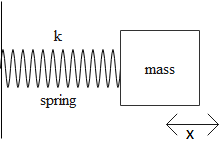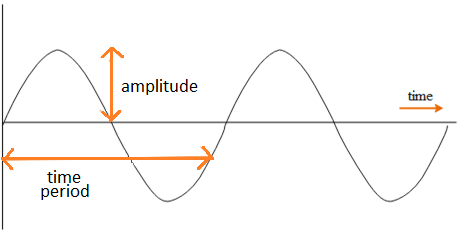
Answer
433.2k+ views
Hint: SHM is a sinusoidal periodic motion in other words it is a motion of repetition or oscillations. The time period is the total time taken by a particle to complete the required work done. The velocity of the motion is inversely proportional to the time period of the motion.
Complete step-by-step answer:
SHM is a special kind of periodic motion in which the restoring force on the moving body is directly proportional to the displacement magnitude of the object and acts towards the object’s equilibrium position.

According to Hooke's law when a mass is attached to a spring whose one end is fixed at a point. For the linear motion, the force required by a body to extend or compress the spring by a certain distance is given by,
${{F}_{s}}=Kx$
Where,
K is the constant factor characteristic of the spring.
x is the displacement of the spring due to expansion or compression of the spring.
The waveform of SHM is sinusoidal and this is calculated by Hooke's law.

The time interval for an SHM is termed as the time period of the motion.
$T=\dfrac{1}{f}$
Where,
$f$ Is the frequency of the wave.
The velocity of the SHM is directly proportional to the frequency it will be inversely proportional to the time of the motion.
$v=\pm 2\pi f\sqrt{{{A}^{2}}-{{x}^{2}}}$
Where,
$A$ is the amplitude
$x$ is the displacement
So,
$\begin{align}
& v\propto f \\
& \Rightarrow T\propto \dfrac{1}{f}\propto \dfrac{1}{v} \\
& \Rightarrow T\propto \dfrac{1}{v} \\
\end{align}$
It is found that when the time interval will be the minimum interval of time required for the motion of the object from a certain point the velocity at that point will be the maximum velocity that can be attained by the object.
So, the correct answer is “Option B”.
Note: Ideally SHM is a constant type of motion. But due to the external opposite hindrances line frictional forces the motion is dissipative. This type of oscillation is known as damped oscillation. And motion with such oscillation is known as damped simple harmonic motion. In this, the energy of the oscillator dissipates continuously.
Complete step-by-step answer:
SHM is a special kind of periodic motion in which the restoring force on the moving body is directly proportional to the displacement magnitude of the object and acts towards the object’s equilibrium position.

According to Hooke's law when a mass is attached to a spring whose one end is fixed at a point. For the linear motion, the force required by a body to extend or compress the spring by a certain distance is given by,
${{F}_{s}}=Kx$
Where,
K is the constant factor characteristic of the spring.
x is the displacement of the spring due to expansion or compression of the spring.
The waveform of SHM is sinusoidal and this is calculated by Hooke's law.

The time interval for an SHM is termed as the time period of the motion.
$T=\dfrac{1}{f}$
Where,
$f$ Is the frequency of the wave.
The velocity of the SHM is directly proportional to the frequency it will be inversely proportional to the time of the motion.
$v=\pm 2\pi f\sqrt{{{A}^{2}}-{{x}^{2}}}$
Where,
$A$ is the amplitude
$x$ is the displacement
So,
$\begin{align}
& v\propto f \\
& \Rightarrow T\propto \dfrac{1}{f}\propto \dfrac{1}{v} \\
& \Rightarrow T\propto \dfrac{1}{v} \\
\end{align}$
It is found that when the time interval will be the minimum interval of time required for the motion of the object from a certain point the velocity at that point will be the maximum velocity that can be attained by the object.
So, the correct answer is “Option B”.
Note: Ideally SHM is a constant type of motion. But due to the external opposite hindrances line frictional forces the motion is dissipative. This type of oscillation is known as damped oscillation. And motion with such oscillation is known as damped simple harmonic motion. In this, the energy of the oscillator dissipates continuously.
Recently Updated Pages
How many sigma and pi bonds are present in HCequiv class 11 chemistry CBSE

Mark and label the given geoinformation on the outline class 11 social science CBSE

When people say No pun intended what does that mea class 8 english CBSE

Name the states which share their boundary with Indias class 9 social science CBSE

Give an account of the Northern Plains of India class 9 social science CBSE

Change the following sentences into negative and interrogative class 10 english CBSE

Trending doubts
Difference between Prokaryotic cell and Eukaryotic class 11 biology CBSE

Which are the Top 10 Largest Countries of the World?

Differentiate between homogeneous and heterogeneous class 12 chemistry CBSE

Fill the blanks with the suitable prepositions 1 The class 9 english CBSE

Difference Between Plant Cell and Animal Cell

Give 10 examples for herbs , shrubs , climbers , creepers

The Equation xxx + 2 is Satisfied when x is Equal to Class 10 Maths

Write a letter to the principal requesting him to grant class 10 english CBSE

Change the following sentences into negative and interrogative class 10 english CBSE



